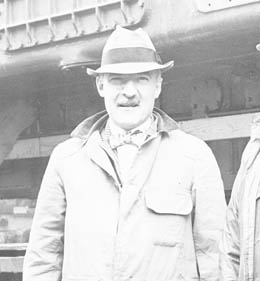On July 4, 1947, Paul Revelle, the Washington State Director of Transportation, denies the request of Captain Alexander Peabody (1895-1980) to raise fares aboard Puget Sound Navigation Company ferries by 30 percent. The state also orders Peabody to provide refunds to passengers retroactive to February 15, 1947, when a temporary increase was granted pending review. A 10 percent increase is granted instead, but Peabody claims that this rate is confiscatory and will cause him to shut down the ferry system. A year later, he follows through on his threat and shuts it down. This in turn shuts down any remaining support for his position and ultimately leads to the creation of Washington State Ferries.
Fare Deals
Peabody had been requesting higher rates since 1945, following the end of World War II. During the war, rates remained steady in the context of the war effort as the ferries transported people to and from the Puget Sound Naval Shipyards in Bremerton, one of the largest Naval shipyards on the West Coast. After the war, ridership dropped and the aging fleet was in need of repairs.
A 10 percent increase in fares had already been granted, causing much consternation amongst ferry riders. The cost of living was rising, and this only added more burden to the pocketbook. Still, Peabody continued to seek further fare increases to offset losses shown and projected by company methods of calculation.
On February 15, 1947, the state granted Peabody’s request for a 30 percent increase, but only temporarily while experts reviewed the Puget Sound Navigation Company’s earnings, operations, rates, services, and facilities. To protect the public, the ferry company was required to provide a dated receipt to each passenger, who would then receive a refund if the state felt that a 30 percent increase was too much.
For the next six months, 32 inspectors and 12 statisticians pored over mountains of data. Public hearings were held at which Peabody defended his increase proposals to a angry public. The public got angrier still when a labor dispute shut down the ferry company in mid-March, 1947, stranding tens of thousands of commuters. People were upset with the fact that Peabody had near-monopolistic control of such a vital link in Puget Sound transportation.
Scorn on the Fourth of July
On July 4, 1947, Transportation Director Paul Revelle announced the results of six months of hearings and studies. Based on analysis and input from both the public and the privately owned ferry system, a 30 percent increase was deemed unwarranted, and only a 10 percent boost would be granted. This meant that a two-thirds refund would be handed over to all ferry patrons who had kept their receipts.
Peabody was hit hard. Instead of setting aside money for refunds, he had spent it on wage increases and boat repairs. He told the press, “Figure it out for yourself. The Department of Transportation is trying to put us out of business. Everything is just lovely for the Fourth of July.” He vowed to fight the ruling, and said that he’d press forward for even higher rates, this time a 40 percent increase.
Revelle stood by his decision, and backed it up with numbers and facts. The state computed the value of the fleet based on actual costs, whereas the company computed the cost of each vessel at the original higher price. Given this, Revelle held that a 10 percent increase would permit a 6 percent return on the company’s cash investment, still allowing a 4 percent dividend to stockholders.
Revelle pointed out that this still left the company with enough funds to replace one vessel every two years. Noting that the number of ferries currently on the Seattle-Bremerton run were not cost-effective, the Department of Transportation directed the company to eliminate one vessel from the route.
No Dough, No Go
Peabody kept fighting. Over the next few months, he threatened to tie up the entire fleet if he did not get the increase he felt was necessary to run his business. The public, which had already gone six days without ferries during the March strike, was less than thrilled with the prospect of losing cross-sound links one more time. State government, which had scrambled to provide alternate transportation during the strike, did not want this to happen again.
Some organized civic groups appealed to Governor Mon C. Wallgren for a state-run ferry system, which would provide more accountability to the public. The governor tended to agree, but kept some distance for the time being. In the height of cold-war paranoia, there were some who felt that a state-run transportation system was a form of “creeping socialism.” Others looked into starting ferry systems of their own, and others still pressed for the creation of floating bridges across Puget Sound.
In 1948, everyone’s fears were realized when Peabody followed through on his threats. Citing lack of funds, he shut down the system for eight days, swaying what little public support he had away from him. At this point, the state began actively pursuing a state-run ferry system, eventually buying out the Puget Sound Navigation Company. This led, in 1951, to the creation of Washington State Ferries.

